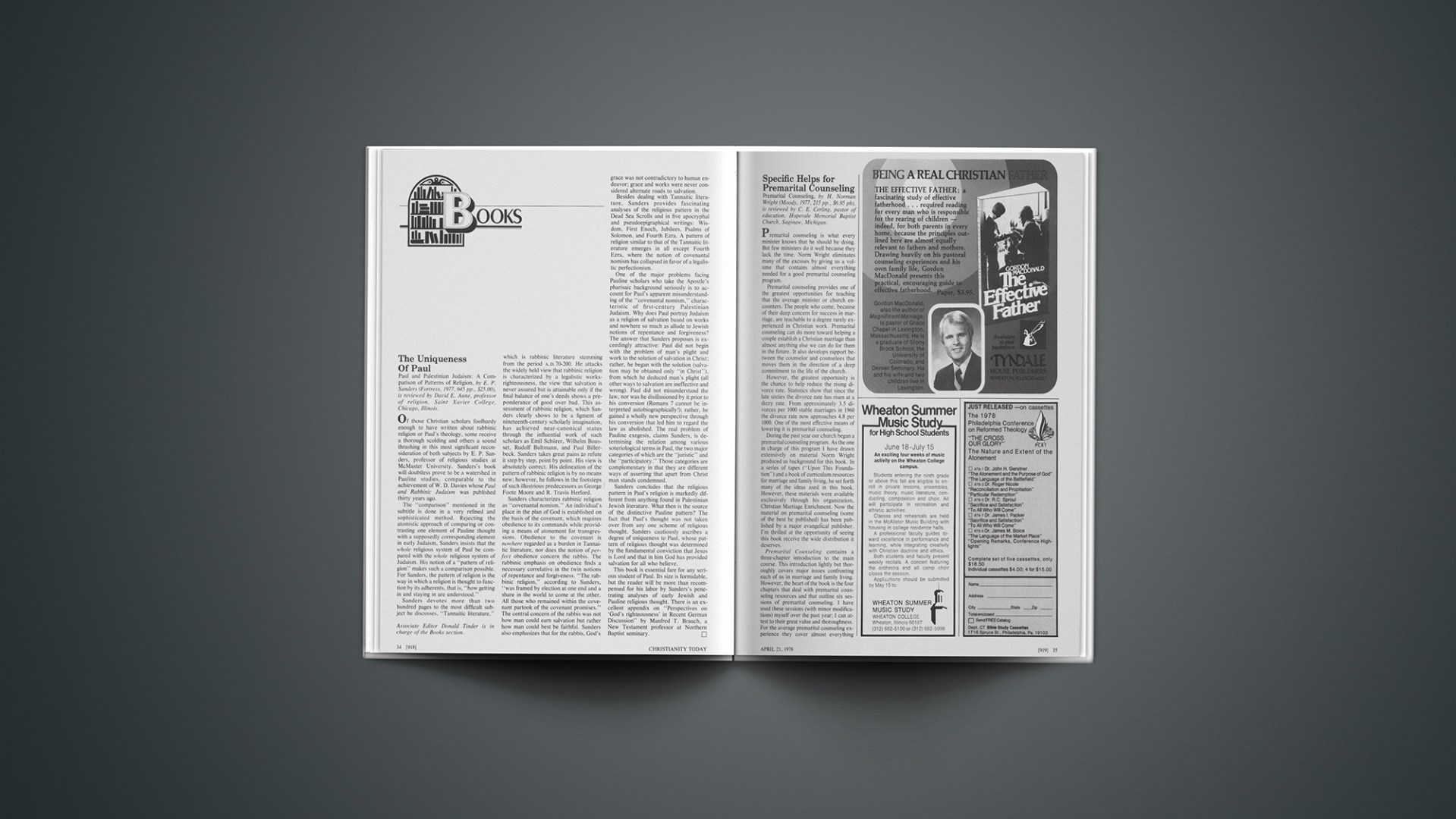The Uniqueness Of Paul
Paul and Palestinian Judaism: A Comparison of Patterns of Religion, by E. P. Sanders (Fortress, 1977, 645 pp., $25.00), is reviewed by David E. Aune, professor of religion, Saint Xavier College, Chicago, Illinois.
Of those Christian scholars foolhardy enough to have written about rabbinic religion or Paul’s theology, some receive a thorough scolding and others a sound thrashing in this most significant reconsideration of both subjects by E. P. Sanders, professor of religious studies at McMaster University. Sanders’s book will doubtless prove to be a watershed in Pauline studies, comparable to the achievement of W. D. Davies whose Paul and Rabbinic Judaism was published thirty years ago.
The “comparison” mentioned in the subtitle is done in a very refined and sophisticated method. Rejecting the atomistic approach of comparing or contrasting one element of Pauline thought with a supposedly corresponding element in early Judaism, Sanders insists that the whole religious system of Paul be compared with the whole religious system of Judaism. His notion of a “pattern of religion” makes such a comparison possible. For Sanders, the pattern of religion is the way in which a religion is thought to function by its adherents, that is, “how getting in and staying in are understood.”
Sanders devotes more than two hundred pages to the most difficult subject he discusses, “Tannaitic literature,” which is rabbinic literature stemming from the period A.D. 70–200. He attacks the widely held view that rabbinic religion is characterized by a legalistic works-righteousness, the view that salvation is never assured but is attainable only if the final balance of one’s deeds shows a preponderance of good over bad. This assessment of rabbinic religion, which Sanders clearly shows to be a figment of nineteenth-century scholarly imagination, has achieved near-canonical status through the influential work of such scholars as Emil Schürer, Wilhelm Bousset, Rudolf Bultmann, and Paul Billerbeck. Sanders takes great pains to refute it step by step, point by point. His view is absolutely correct. His delineation of the pattern of rabbinic religion is by no means new; however, he follows in the footsteps of such illustrious predecessors as George Foote Moore and R. Travis Herford.
Sanders characterizes rabbinic religion as “covenantal nomism.” An individual’s place in the plan of God is established on the basis of the covenant, which requires obedience to its commands while providing a means of atonement for transgressions. Obedience to the covenant is nowhere regarded as a burden in Tannaitic literature, nor does the notion of perfect obedience concern the rabbis. The rabbinic emphasis on obedience finds a necessary correlative in the twin notions of repentance and forgiveness. “The rabbinic religion,” according to Sanders, “was framed by election at one end and a share in the world to come at the other. All those who remained within the covenant partook of the covenant promises.” The central concern of the rabbis was not how man could earn salvation but rather how man could best be faithful. Sanders also emphasizes that for the rabbis, God’s grace was not contradictory to human endeavor; grace and works were never considered alternate roads to salvation.
Besides dealing with Tannaitic literature, Sanders provides fascinating analyses of the religious pattern in the Dead Sea Scrolls and in five apocryphal and pseudoepigraphical writings: Wisdom, First Enoch, Jubilees, Psalms of Solomon, and Fourth Ezra. A pattern of religion similar to that of the Tannaitic literature emerges in all except Fourth Ezra, where the notion of covenantal nomism has collapsed in favor of a legalistic perfectionism.
One of the major problems facing Pauline scholars who take the Apostle’s pharisaic background seriously is to account for Paul’s apparent misunderstanding of the “covenantal nomism,” characteristic of first-century Palestinian Judaism. Why does Paul portray Judaism as a religion of salvation based on works and nowhere so much as allude to Jewish notions of repentance and forgiveness? The answer that Sanders proposes is exceedingly attractive: Paul did not begin with the problem of man’s plight and work to the solution of salvation in Christ; rather, he began with the solution (salvation may be obtained only “in Christ”), from which he deduced man’s plight (all other ways to salvation are ineffective and wrong). Paul did not misunderstand the law, nor was he disillusioned by it prior to his conversion (Romans 7 cannot be interpreted autobiographically!); rather, he gained a wholly new perspective through his conversion that led him to regard the law as abolished. The real problem of Pauline exegesis, claims Sanders, is determining the relation among various soteriological terms in Paul, the two major categories of which are the “juristic” and the “participatory.” Those categories are complementary in that they are different ways of asserting that apart from Christ man stands condemned.
Sanders concludes that the religious pattern in Paul’s religion is markedly different from anything found in Palestinian Jewish literature. What then is the source of the distinctive Pauline pattern? The fact that Paul’s thought was not taken over from any one scheme of religious thought. Sanders cautiously ascribes a degree of uniqueness to Paul, whose pattern of religious thought was determined by the fundamental conviction that Jesus is Lord and that in him God has provided salvation for all who believe.
This book is essential fare for any serious student of Paul. Its size is formidable, but the reader will be more than recompensed for his labor by Sanders’s penetrating analyses of early Jewish and Pauline religious thought. There is an excellent appendix on “Perspectives on ‘God’s righteousness’ in Recent German Discussion” by Manfred T. Brauch, a New Testament professor at Northern Baptist seminary.
Specific Helps For Premarital Counseling
Premarital Counseling, by H. Norman Wright (Moody, 1977, 215 pp., $6.95 pb), is reviewed by C. E. Ceding, pastor of education, Hopevale Memorial Baptist Church, Saginaw, Michigan.
Premarital counseling is what every minister knows that he should be doing. But few ministers do it well because they lack the time. Norm Wright eliminates many of the excuses by giving us a volume that contains almost everything needed for a good premarital counseling program.
Premarital counseling provides one of the greatest opportunities for teaching that the average minister or church encounters. The people who come, because of their deep concern for success in marriage, are teachable to a degree rarely experienced in Christian work. Premarital counseling can do more toward helping a couple establish a Christian marriage than almost anything else we can do for them in the future. It also develops rapport between the counselor and counselees that moves them in the direction of a deep commitment to the life of the church.
However, the greatest opportunity is the chance to help reduce the rising divorce rate. Statistics show that since the late sixties the divorce rate has risen at a dizzy rate. From approximately 3.5 divorces per 1000 stable marriages in 1960 the divorce rate now approaches 4.8 per 1000. One of the most effective means of lowering it is premarital counseling.
During the past year our church began a premarital counseling program. As the one in charge of this program I have drawn extensively on material Norm Wright produced as background for this book. In a series of tapes (“Upon This Foundation”) and a book of curriculum resources for marriage and family living, he set forth many of the ideas used in this book. However, these materials were available exclusively through his organization, Christian Marriage Enrichment. Now the material on premarital counseling (some of the best he published) has been published by a major evangelical publisher. I’m thrilled at the opportunity of seeing this book receive the wide distribution it deserves.
Premarital Counseling contains a three-chapter introduction to the main course. This introduction lightly but thoroughly covers major issues confronting each of us in marriage and family living. However, the heart of the book is the four chapters that deal with premarital counseling resources and that outline six sessions of premarital counseling. I have used these sessions (with minor modifications) myself over the past year; I can attest to their great value and thoroughness. For the average premarital counseling experience they cover almost everything necessary. In fact, our church is so pleased with them that in time this whole program will be placed in the hands of lay couples who will do the counseling in their homes, thus freeing a major portion of ministerial time for other duties.
Sessions one and two explore the following subjects: What is marriage?, the couples’ family backgrounds, their dating background, the extent of their present sexual involvement, their preparation for marriage, their attitudes toward marriage, their definitions of love, and what they anticipate from marriage. The other sessions are equally thorough.
Each session includes homework to be done before the beginning of the next session. There is even homework for the couple before the counseling actually begins. In all, between twenty-five and thirty hours of homework are required.
How do people react to such extensive preparation? Let me give you a few reactions. A young man asked shortly before he and his fiancé dropped out, “Do all the churches in town require this much preparation to get married?” But others have said, “This is one of the greatest things I have ever experienced.” It has been my experience that couples who complete the course have nothing but praise for its contents. I have both a premarital counseling class and an individual counseling program, but those involved always share their appreciation for what they learn.
If there is one weakness in this book it is the chapter dealing with special problems in premarital counseling. It is too short (ten pages). The issue of mixed marriages, Christian/non-Christian marriages, could have been explored in far more depth. Another problem I face regularly is the divorced person who wants to marry again. These are sticky issues that cannot be lightly handled. I was surprised that no mention was made in the bibliography on divorce of Dwight Small’s The Right to Remarry.
Another question needs to be handled in more detail: how should a minister respond to the couple who is sleeping together? Wright suggests to tell them to stop. If they do not, counseling will not continue. He says that he has not encountered couples who refuse to follow his advice. I sure have. To insist that they stop sleeping together or I will stop counseling them, places a couple in a position of lying about what they are doing if they don’t want to stop. Further, it would be difficult to check up on them to determine the facts.
This criticism, however, should not detract from the value of this book. For too long the church has been involved in conducting weddings when it should have been creating Christian homes. For years we have needed a thorough plan of action for premarital counseling. Wright gives us a good one. We might want to modify it for our own use, but at least we should begin by making use of it.
A Police Chaplain In Hawaii
Calling Angel One, by Bob Turnbull (Bible Voice, 1976, 175 pp., $2.95 pb), is reviewed by John de Vries, Protestant chaplain, Centre Federal de Formation, Laval, Quebec.
The down-to-earth police chaplain of Waikiki Beach, Bob Turnbull, writes an adventurous account of his experiences as a “Jesus Cop.” What is an ordained minister doing as a police chaplain on this exotic, Pacific, “Hawaii Five ‘O’ ” playground? As the reader travels with him he sees how Jesus enters into the lives of prostitutes, pimps, and pushers.
This is not simply a book about “spirtual highs.” The reader is called to thoughtful reflection and Christian discipleship. The author successfully promotes lay and clergy interest in the new and specialized ministry of the police chaplain. “Needs are visible everywhere,” writes the author. The police, the law breakers, the victims, and the community need to be ministered to through the “Christ presence” of the chaplain. Numerous police chaplaincies are now being established. Any church can show interest in the local police force, which could lead to creation of a police chaplain in the community. The author’s many anecdotal accounts illustrate both the difficulties and the rewards of this ministry.
Young people will enjoy this fast-moving book. Church groups might develop projects to work with the local police. Ministers and deacons who want to broaden the ministry of the local congregation will be stimulated and challenged. For immediate assistance the author has included in the appendix the “Police Chaplain’s Handbook” and a description of “The Role of the Volunteer Police Chaplain.”
Tensions In The Church
The Church in the Power of the Spirit, by Jürgen Moltmann (Harper & Row, 1977, 407pp., $15.00), is reviewed by Donald G. Bloesch, professor of theology, University of Dubuque Theological Seminary, Dubuque, Iowa.
In his latest book Moltmann seeks to reinterpret the doctrine of the church. He rejects the older conservatism of Abraham Kuyper and August Vilmar, which in his mind sought to identify the church with the ruling order against chaos and revolution. The true church will see its goal as the liberation of the oppressed and downtrodden of the world, and such liberation entails both personal freedom and social emancipation. He disdains the traditional emphasis that the church’s mission is to convert people to the Christian religion; instead it is to implant the seeds of liberation in the hearts and minds of the oppressed.
While he reaffirms the historical understanding of the marks of the church as holiness, apostolicity, catholicity, and unity, Moltmann adds the sign of the liberating witness of the church in conflict with the powers of the world. He sees the holiness of the church in terms of its poverty, its willingness to confess its guilt. Apostolicity is manifested in continuity with apostolic doctrine and faithfulness in carrying out the apostolic charge. The church is catholic and related to the whole insofar as it seeks to restore to favor the lost, the rejected, and the oppressed. The evidence of the sanctification of the church is its suffering and persecution in resisting the principalities and powers of every age.
Moltmann sees the New Testament church as charismatic, not hierarchical. The development of the monarchial episcopate led, in his opinion, to the quenching of the Spirit and was an impediment to the charismatic church. He calls for the discovery and practice of “the free abundance of the Spirit’s gifts.” These gifts and ministries have for their purpose “the messianic liberation of the world.” Deadness, not enthusiasm, is the bane of the modern church. The fullness of the Spirit should not be “smothered by established and regimented forms of worship.”
Recognizing the salutary role of monastic orders in the church of the past, he calls for the formation of “regulated discipleship groups” that will demonstrate the liberty of Christ more unhesitatingly than church leaders and more radically than the ordinary laity. Yet he warns that such groups will isolate themselves in a social ghetto if they do not seek to have a reforming effect on both church and society.
His view of the sacraments combines elements from Reformation theology and the Anabaptist and Pietist traditions. While affirming believer’s baptism only, he makes a place for the blessing of children in the service of worship. He contends that the Lord’s Supper should not be conducted by a special priestly caste but should be celebrated by the whole congregation. The invitation to partake should be extended to unbelievers as well as believers.
In place of the communion of saints Moltmann substitutes the “fellowship of friends.” A friend is anyone who loves in freedom, and this means that the fellowship of love extends beyond the frontiers of organized Christianity. By friendship Moltmann does not mean selective intimacy based on common interests; he has in mind an open and total friendship that goes out to meet others in the spirit of love.
He sees positive values in the world religions and therefore believes that the church’s role should be not to try to win people to faith in Christ but instead to join with people of other faiths in the alleviation of the world’s distress. The coming of the redeeming kingdom rests partly “in the potentialities and powers of the world religions.” In inter-religious dialogue the Christian role is to encourage people of other religions to discover and activate their charismatic potentialities in the service of liberation and humanization. Thereby the world religions are given messianic direction and serve to prepare the way for the coming kingdom. Moltmann even allows for the possibility of Hindu, Muslim, and Shintoist and animist forms of Christianity.
While discouraging missions to the Jews, Moltmann regards the state of Israel as having messianic significance. It is a sign of the end of the dispersion and “the beginning of Israel’s homecoming.” Interestingly he is favorably disposed toward millennialism, since it “vanquished anti-Judaism by vanquishing ecclesiastical absolutism.” Because the church in the past so often understood itself as the messianic kingdom of Christ, it could not “acknowledge Israel’s separate existence alongside itself.”
The hope of the church is not life with God in eternity but the future of this world as changed by the kingdom of God. He sees transcendence in terms of the eschatological future into which we are raised by faith. The church is not yet the kingdom of God, but it witnesses to this kingdom, which has already been inaugurated in Jesus Christ and is destined to encompass all peoples and all history.
Moltmann maintains that the real division in the church today is not doctrinal but political. This division crosses all denominational lines, since the class conflict between the oppressed and the oppressors is not restricted to any church or nation. I would contend, against Moltmann, that behind the political tensions within the churches lies a growing doctrinal cleavage that augurs ill for the unity of the church in the future.
What makes evangelicals uneasy about Moltmann’s theology is not his call for identification with the oppressed and the poor of this world, since this indeed has a New Testament basis; instead it is his understanding of God as immanental in history rather than transcendent over history, his view that all humankind is already justified by God irrespective of faith, his monism of grace, which includes all world religions in redemptive history, and his reinterpretation of mission as political and social liberation rather than the call to a faith commitment to Jesus Christ.
Briefly Noted
Sherwood Wirt, well-known journalist and former editor of Decision magazine, shares his tips about the journalism trade in Getting Into Print (Nelson. 132 pp., $2.95 pb). Included with the basic principles are an interview with C. S. Lewis and a discussion of the Christian journalist’s role.
Work consumes 40 per cent of a person’s waking hours, and all too often it becomes either a tyrant or a source of frustration. Mary and Jerry White attack these and other problems in Your Job—Survival or Satisfaction? (Zondervan, 191 pp., $6.95). Their purpose: to provide principles and practical applications that enable a Christian to put his job into perspective.
Will D. Campbell is known as a Southerner, preacher, civil rights activist, and father-advisor to people as diverse as Andrew Young and the Grand Dragon of the Ku Klux Klan. Brother to a Dragonfly (Seabury, 268 pp., $9.95) is the story of Campbell’s relationship with his older brother, a relationship that ended with the brother’s suicide. The book reveals far more than two people’s lives, however. It is a portrait of the enigmatic deep South during the Depression and its painful awakening with the civil rights movement.
An update of a previous work. Counseling the Homosexual by John R. Cavanaugh (Our Sunday Visitor, 352 pp., $14.95) is written by a medical doctor for professionals. Most of the material is background information on homosexuality with only a short section on counseling techniques. Theologically, the perspective is conservative Catholic.
Bible students with a special interest in archaeology will welcome A Preliminary Near East Periodical Index compiled by John Elliott. All of the articles in five major scholarly journals are indexed not only by author but by one or more categories such as location, book of the Bible, or particular ancient language. A much larger index is in the works, but meantime this one is available for $5 from Samuel Schultz, Wheaton College, Wheaton, IL 60187.
A beautiful volume of poetry and art has been published by Grossmont Press (7071 Convoy Ct., San Diego CA 92111). A Part of Me ($39.95) contains reproductions of fifty of Betty McClellan’s original oil paintings, which are detachable for framing, and each is accompanied by a poem.
Homosexuality and the Christian Faith, edited by Harold Twiss (Judson, 110 pp., $3.95 pb), is a collection of nine previously published articles from widely varied viewpoints. It explains what Christians are thinking on the subject.
Bombarded by the sophisticated use of media and creative teaching methods in the public schools, children are no longer content to endure boring Sunday school classes. As in the public schools, interest has to be earned. Several recent books give practical advice to help Sunday school teachers of younger students enliven their teaching. Spicing up a story by combining quickly drawn scenes with a narrative is the subject of Sketching and Telling Stories to Children (Zondervan, 57 pp., $2.95 pb) by Keith Thompson. Easy-to-follow instructions are given, followed by eighteen stories complete with suggested illustrations and techniques. For the teacher who absolutely cannot draw, Augsburg has a solution. In three large page paperbacks Help, I Can’t Draw! ($2.95 each), Sheila Pigrem provides hundreds of people, buildings, backgrounds, and animals to trace. These figures can then be colored and used to create illustrations, friezes, collages, or flannelgraph figures. Puppetry also pleases children. Give Puppets a Hand (Baker, 104 pp., $4.95 pb) by Violet Whittaker contains thorough directions for creating puppets along with a wide variety of scripts. Practical Puppet Plays (Gospel Publishing House, 61 pp., $2.50 pb) by Irvy Gilbertson is limited to seventeen puppet scripts classified according to age. For an all purpose book on classroom extras, see Teaching Tools You Can Make (Victor, 110 pp., $3.95 pb) by Lee Green. This book is especially appealing because of its wide range of suggestions and its emphasis on recycling throwaway items for creative teaching aids.
Christians have long argued that education is not complete without a study of religion, because of its impact on history, literature, and language. The Supreme Court has finally agreed, and the doors for including religion in public school curricula are now opening. Teaching About Religion in Public Schools (Argus, 258 pp., $3.95 pb) edited by Nicholas Piediscalzi and William Collie is designed to help teachers take advantage of this opportunity by showing how religion can be included. Written by experts, the book deals with both elementary and secondary age levels and subjects, and it often includes example lesson plans.
This book, which in my opinion is Moltmann’s best, can be recommended on the basis that it contains challenging and creative insights that can be used by the discriminating reader in the service of church renewal. I have difficulty with Moltmann’s views on eschatology and with his depiction of the true church, particularly where charism is emphasized to the detriment of structure; yet what he says about apostolicity, holiness, and suffering as marks of the church has much biblical support and can be helpful in the Protestant-Catholic dialogue. His understanding of spirituality as signifying not just the inner life of devotion and prayer but the whole of life under the guidance of the Holy Spirit has biblical foundation and ecumenical promise. Moltmann represents the theology of liberation at its best, and those who wish to know more about this theology would do well to study this creative and searching theologian who stands, even if somewhat tenuously, in the Reformed tradition.
A Call For Imagination
Theopoetic: Theology and Religious Imagination, by Amos Niven Wilder (Fortress, 1976, 106 pp., $4.95), is reviewed by Robert K. Johnston, assistant professor of religion, Western Kentucky University, Bowling Green, Kentucky.
Amos Wilder, now retired from Harvard Divinity School and a former president of the Society of Biblical Literature, is one of the pioneers in the field of religion and literature. He has continued his distinguished career in writing with this small, provocative book on the relationship of the human imagination and divine grace. He has sought to be faithful to the demands both of the aesthetic enterprise and of the biblical narratives. The book is more suggestive than concrete; its semiaphoristic style encourages the redder to pause and imaginatively reflect on its pages.
Wilder believes that it is only “on the level of the imagination that any full engagement with life takes place.” Thus, to the theological task in the church must be added the theopoetic. There would be “a suffocation of the human heart were it restricted to logic.” A contemporary theopoetic will be preliminary to theology, providing it its ruling metaphors and idioms. Before the message there must be a vision; theology needs the religious imagination as its resource. Rooted in the experience of man’s full creaturehood—in creation—and deepened by interaction with the biblical drama, the theopoetic vision remains prerational, providing faith room to breathe and theology a richer agenda.
A claim for theopoetics is not a denial of the theological task, nor a plea for an arbitrary mysticism, nor, again, a claim that imagery and ritual are superior to love and action. Instead, the theopoetic should function to revitalize traditional theology, deepen contemporary spiritualism, and strengthen Christian action by giving each of them a truer vision and a more meaningful celebration. A plea for the theopoetic is not, for Wilder, a call for the symbolic or imaginative in any guise; it is not a baptism of aestheticism. Rather the theopoetic is a call for a mature imagination, one which has an antecedent discipline and a resultant human value.
Unfortunately, too much of contemporary religious imagery and symbolism has become stereotypical, and thus unable to work its charm. The theopoetic is absent. The church, therefore, needs to let its wider culture teach it new spiritual sensibilities and images from the full human repertoire of experience. This is made difficult, however, for there are many competing claims for spiritual insight in modern culture. How do we judge possible momentary theophanies? Although the Christian must be open to the Spirit of creation in all contemporary experiences, he must also be cautious of modern spiritual expressions, testing them by the biblical narrative. Wilder believes that, according to this criterion, people are in error who support the new polytheism, theologies of play, and theologies of “parable.” For each would deny the religious imagination its total vision of man.
A theopoetic can renew biblical faith by revitalizing our reason and enriching our action. Here is its internal function. A theopoetic can also help deepen and/or challenge the mystical expressions of contemporary culture by providing a maturation of vision, enriched by interaction with the biblical witness. Here is its external function.
Wilder’s book shies away from the programmatic; it is itself a vision, which needs fleshing out. How one effectively correlates our new “spiritual” illuminations from society, for example, with the older biblical traditions, without silencing the one or truncating the other, is not always clear. But as a stimulus for thought, the book is an important contribution to the Christian community.
Evangelicals in particular need to hear Wilder’s challenge. We have too often undervalued the aesthetic (the “Refiner’s Fire” of this magazine being a notable exception). Wilder makes the intriguing suggestion that the theme of theology (the glory of God) needs a theopoetic even more than it needs a theology. Worship and adoration through dynamic speech and dramatic image is the first order of business for the Christian; critical reflection, though necessary, remains second.
Did Solomon Really Mean That?
Solomon on Sex, by Joseph C. Dillow (Nelson, 1977, 197pp., $6.95), is reviewed by Donald L. Norbie, Bible teacher, Greeley, Colorado.
There is a spate of Christian books on the market today dealing with sex. This is to be expected. The church is constantly reacting to its culture, and Western culture today is sensual and sex-obsessed. So, Christian writers are vigorously stating that sex is beautiful; God made it; let’s enjoy it.
Joseph Dillow has had many years of experience as a marriage counselor, and he is completing doctoral studies at Dallas seminary. He uses the Song of Solomon as a setting for instruction concerning marriage, especially the sex act. He does not accept the allegorical interpretation of the book. Many Jewish rabbis taught that the book depicted Jehovah’s love for Israel. And many Christian teachers have seen in it an allegory of Christ and the church. In their attempt to spiritualize the language interesting views have been advanced, such as that the bride’s breasts typify the Old and New Testaments.
Dillow takes the language literally: “We want to remove these metaphysical mists and take a clear look at God’s guidelines for sex, love and marriage.” He views the book as the intimate diary of the sensual love of Solomon and Shulamith, a country maid who captured Solomon’s heart.
Each chapter covers a section of the Song. First the setting is given. Then the text is discussed, with special attention paid to the various sensual terms. The chapter concludes with comments and practical application to present-day marriage difficulties.
Like Tim LaHaye in The Act of Marriage Dillow is deeply concerned for the physical fulfillment of marriage. This important part of marriage has often been neglected. Many couples will get practical help for their sexual lives from books such as LaHaye’s or Dillow’s.
In years past Christians may have been too prudish and inhibited sexually; now there may be a danger in following the world in its obsession with sex. The chief end of man is not an orgasm. Dillow seems to read into some of the expressions in the Song of Solomon more explicit sexual references than are intended. A general romantic expression becomes for him a specific sexual description. He states that “The female genitals are referred to in 5:1 as a ‘garden’ and in 4:13 as ‘shoots.’ ”
On chapter 2:3 he says, “it is possible that here we have a faint and delicate reference to an oral genital caress.” A remark like this is exegetically unwarranted. Concerning “a garden locked is my sister” (4:11) he states that “the garden refers to her vagina.” Beautiful poetic descriptions of the person as a whole are seen as describing her sexual organs. Apparently Solomon was writing a sex manual rather than a romantic poem. As an exegesis of the Song of Solomon this book could do better. Perhaps it should be entitled “Dillow on Sex.”
Periodicals
One of the best ways to keep up with theological scholarship is to join Theological Students Fellowship, a division of Inter-Varsity. One does not have to be in college or seminary. The key benefits are a joint subscription to the thrice-yearly international journal, Themelios (the Greek word for foundation), which we have often commended for its articles and reviews, and to a new periodical, TSF News and Reviews, which is to appear three or four times a year and is edited by several North American scholars. It has some news, but contains mostly reviews and bibliographical articles together with forms for ordering selected scholarly books and articles at reduced prices. To join/subscribe for a year send $5 to TSF, 233 Langdon St., Madison, WI 53703.










